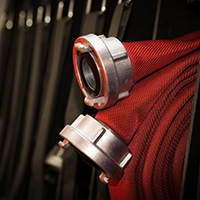
At Flex Technologies Incorporated, we specialize in supplying quality hoses for a wide range of industrial and commercial uses. Our silicone hoses are used in countless applications, found in everything from race car engines to manufacturing plants that fabricate liquid mascara. So perhaps it’s fitting that today, we’ve decided to focus on weird facts about hoses, just for fun!
If you want to learn more about our top-quality silicone hoses, including high-temp silicone tubing options, read our Frequently Asked Questions. But if you’re in the mood for a little light reading, take a moment to read our just-for-fun blog covering weird and fascinating facts about hoses.
Fact #1: The first-known practical fire hose was invented back in 1673 in Holland.
These early hoses were made from materials that were available at the time, typically either leather or sailcloth, as well as brass screw threads. Excessive water pressure often resulted in burst seams.
Fire hoses were adapted in the early 1800s by firemen in Philadelphia, Pennsylvania, to make them nearly leak-proof. This was accomplished through the use of copper rivets to bind seams.
Thankfully, by the 1820s there was a significant shift away from leather as rubber became the hose material of choice, championed by B. F. Goodrich and other industrialists and entrepreneurs. In many ways, rubber was the superior choice, primarily for its flexibility and the fact that it’s easier to maintain. Read “A Short History Of Hose” to learn more about the origins of the fire hose.

Fact #2: Garden hoses originated from fire-fighting hoses.
Today’s common (but very practical) garden hose is made from rubber or vinyl, or a combination of the two. These materials can be reinforced for added strength. The garden hose evolved from fire hoses, which came first because the need to combat fires was far more pressing than finding an easier way to water the garden!
Fact #3: A dripping hose bib can lose a significant amount of water, up to 2,160 gallons a year.
There’s a good reason to fix that leaky faucet or take care of a dripping hose bib. These small drips can add up to huge losses of water. In just a month, up to 180 gallons can be lost through a slow-drip leak. Multiply 180 gallons times twelve months, and you have a staggering loss of 2,160 gallons per year. Save that water (and save on utility bills) by fixing dripping hose bibs, both at home and at your business!
Fact #4: Generally, it’s not safe to drink from garden hoses.
When you were a kid, your parents may have warned you not to drink from a garden hose. They were right; it most likely isn’t safe. That’s because many garden hoses are treated with chemicals to make them more water-tight and leak-resistant. These chemicals can seep into the water the garden hoses transport, making them unsafe to drink from. Make sure that neither you nor your children or pets drink water straight from a garden hose.
Fact #5: If your washing machine hose fails, you could lose up to 650 gallons per hour.
Washing machine hoses could benefit from periodic checks and replacement, because a failing one can lose a significant amount of water. You know what a gallon jug of water looks like; now imagine 650 of those spilled all over your floor because of a burst washing machine hose. That would be a nightmare!
Fact #6: Hose museums exist all over the U.S.!
They may be referred to as hose museums, but more accurately, they are firefighter museums that record and display an important part of the town’s history. Here’s a partial list of “hose museums” worth checking out:
- Alpine Hose #2 Firefighter Museum: Located in the quaint mountain town of Georgetown, Colorado, this museum serves as an important historical symbol.
- Hose 5 Fire Museum: If you find yourself in Bangor, Maine, stop by this museum housed in a lovely historic building that dates back to 1897.
- Capen Hose Co. No. 4 Fire Museum: This treasure of a museum located in Brockport, New York showcases firefighting memorabilia, including historic helmets and a lovingly restored steam pumper.
- Fire Hose Cart Museum: The Nantucket Historical Association in Massachusetts has carefully restored this beautiful building that now houses vintage hose carts and pumpers.
Fact #7: The same material found in high-performance silicone hoses is also found in fluffy towels.
Some of the fluffiest towels around are purposely made that way using silicone, which also features prominently in high-performance hoses used in the production of pharmaceuticals, in the processing of foods, and in water-purification systems, among many other applications.
Silicones are added to fabrics to make your towels fluffy, cozy, and absorbent. (You can learn more interesting facts about silicone by reading our previous blog post, “Fascinating Facts About Silicone.”)

And Now, Back To Our Top-Quality Silicone Hoses!
Now that you’ve learned some unusual hose-related facts, let’s get back to business. At Flex Tech, we supply high-performance silicone hoses used by companies in many different industries, including aerospace, cosmetics manufacturing, and refrigeration, to name a few. We can supply you with top-quality off-the-shelf parts, or we can work with you to develop custom-fit solutions for your particular application.
Our OEM capabilities enable us to meet the highest manufacturing and design standards for a superior product and better solutions for our clients. Our in-house staff includes a group of analytical, technologically savvy individuals who are ready to work with you on your designs. For all your silicone hose needs, turn to Flex Technologies today!
 Default Currency
Default Currency
 Mexican Pesos
Mexican Pesos
 Canadian Dollar
Canadian Dollar


